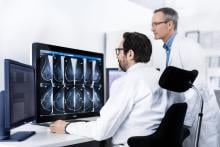October 17, 2018 — Nanosonics announced the commercial availability of its Trophon2 high level disinfection (HLD) system for ultrasound probe decontamination in the United States and Canada. The new device, which prevents exposure to hazardous chemicals, offers medical professionals a smart solution that helps ensure compliance with the latest guidelines for reprocessing of surface and endocavity ultrasound probes.
© Copyright Wainscot Media. All Rights Reserved.
Subscribe Now

